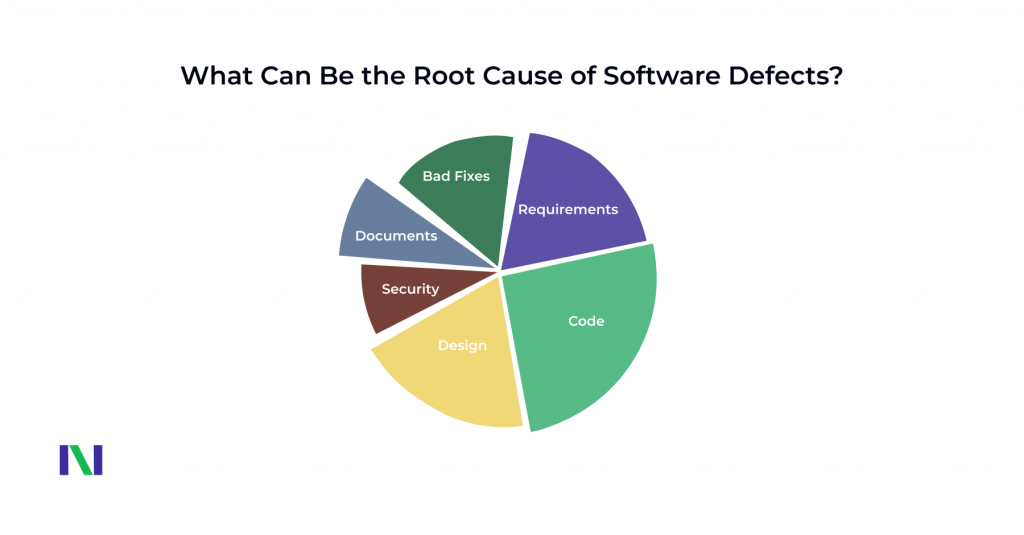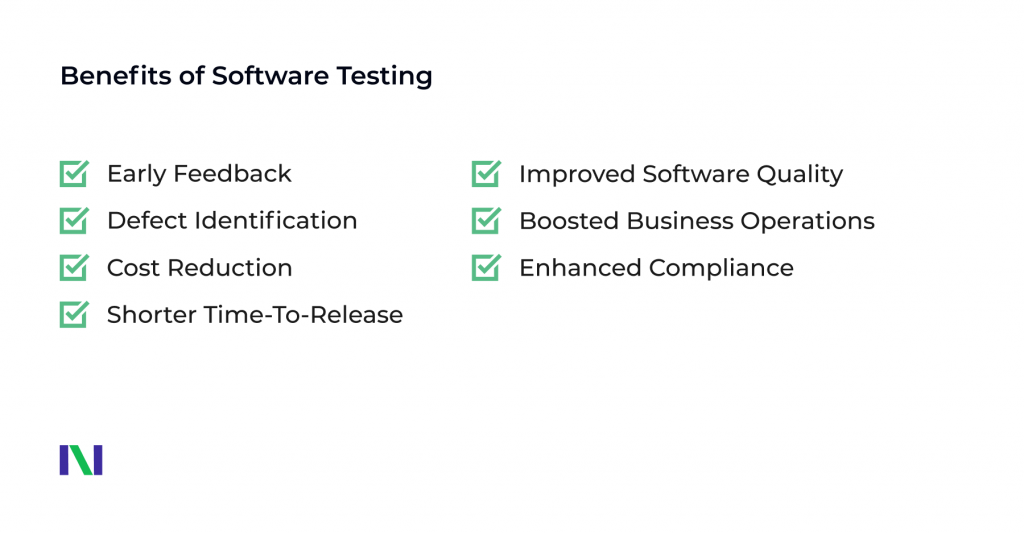
Table of Contents
Have you heard of defects in software testing? Yes, those that bug software users and negatively influence app performance.
There’re many types of bugs in software testing that occur during the software development process. In this article, we define what is a bug in software testing, overview the most common software bug types, and explain why bugs testing is an important part of software development.
It’s going to be insightful.
Impossible to not detect bugs in software testing. Software is created by people, and you know, people normally make mistakes. In addition, customers may not use your solution as they are expected to use it, for example, enter invalid data. As a result, your software bugs become evident to all your users.
So what are these software defects?
A software defect (a bug) is an error in a program that causes it to work incorrectly and (or) unpredictably. A software defect definition also includes the difference between the actual and expected result.
As bugs in software are made while writing the code, your software may not perform the pre-planned features, work in a way that differs from your specifications, or perform actions that it shouldn’t. Such cases are called program failures.
Every software has either these or those types of software bugs. Moreover, bugs often remain there even after the official release. This is because detecting all bugs in the software testing process is nearly impossible. Application bugs might appear due to the lack of time, resources, or simply improper input values and an arrow in validation scripts.
A released software usually comes with minor bugs. Major and critical bugs come fixed.
Software development is a huge field that includes:
And way more, in fact.
Each of the software development branches has its bug classifications. However, in our article, we’ve focused on the most widespread and most typical bugs found in software and app.
BUG TYPES DESCRIPTION
LOGIC ERRORS
We believe this is the most serious type of software bug. A program (written in any language) runs correctly but produces the wrong output. The flaw here is in the underlying programming logic. These types of defects are inherited from a flaw in the underlying algorithm. The logic on which the entire software is based is flawed.
Finding a solution to this error requires a fundamental change in the software algorithm.
SYNTAX ERRORS
Computer languages such as C, Java, Perl, or Python have their specific syntax. Every time a developer fails to adhere to the “grammar” of the computer language specifications, a syntax error will occur.
These software bug types are easily eliminated at the compilation stage.
COMPILATION ERRORS
Compilation is the process of converting a program written in a high-level language into a machine-readable form. Many types of bugs can occur at this stage, including syntax errors. Even in the case when the syntax of your application source code is flawless, a compilation error can still occur. This often can be due to a problem in the compiler itself. These software bugs are fixed at the development stage.
RUNTIME ERRORS
The program code was compiled successfully and the executable file was created. You breathe a sigh of relief and run your software to see how it works. Errors during software usage can occur as a result of a crash or a lack of media resources. Your dedicated team of developers needs to anticipate the actual deployment conditions of your software. These types of software defects can be fixed by going back to the coding stage and refining it all there.
RESOURCE ERRORS
Resource errors occur when the value of a variable overflows the maximum allowed value. Such bug examples include:
COMMUNICATION ERRORS
These types of software defects arise due to a software-hardware mismatch, mismatch with your application interface. If we’re talking about web applications, an interface error can come as a result of misuse of the web protocol.
You surely understand that simply overviewing the bug categories is not enough to secure your software from software defects. Apart from understanding the bug definition in software testing, it’s also important to realize the root causes for bugs to appear.
Normally, software bugs occur at the moment the three following conditions are met simultaneously:
However, not all bugs cause software failures. Some of them may not manifest themselves in any way and remain unnoticed (or as it often happens appear only under very specific circumstances).

Software operation failures can be caused not only by defects but also by environmental conditions such as, radiation, electromagnetic fields, or pollution. They can affect the operation of both software and hardware.
Root causes of software defects and failures include:
Defects can occur at different levels of a QA process flow. Your software quality will directly depend on whether these defects are corrected and at which stage.
Below we provide 4 software bugs examples to clarify what is a defect in software testing and what are the main reasons for software defects on the whole.
A successful software development process has the following flow:
Correct requirements → design project according to the requirements → development according to the design project → software solution that works correctly ⇒ Voila. Everything done correctly.
In this case, everything is done correctly and we receive a software or an app product that fully satisfies the customer’s expectations and meets the quality criteria.
Correct requirements → design project according to the requirements → software development defects → solution defects
⇒ software solution with resolvable defects.
In this case, the errors are made on the code writing stage, which leads to defects in the final product. At this level however, bugs are easy to spot and fix, as we see non-compliance.
Correct requirements → design project with defects → software development defects → solution defects
⇒ software solution that needs to be revised from the design stage.
This option is worse than the previous one as the mistakes made are at the system design stage. These can only be noticed by conducting a thorough software quality check with the specifications. Correcting such software defects is not that easy as now it’s necessary to redesign the whole solution.
Wrong requirements → design project with defects → software development defects → solution defects
⇒ software solution with non-resolvable defects.
In this case, defects are laid down at the stage of setting up the requirements. Any further development and testing go down the initially wrong path. During testing, no bugs are detected as the solution passes all tests. However, your software or your app is still rejected by the ultimate user.
NEKLO pays close attention to solution quality when working on projects and offers second opinion services to clients to help identify defects in their current software and apps as well as provides a way to rework it or rebuild it from scratch.
Summing up all the types of defects in software testing and keeping in mind the software bug classification, we have outlined 5 main reasons for software defects:
Business requirements can sometimes not reach the development team. The client has an understanding of how they want the finished product to work. However, if their idea is not properly explained to your dedicated development team and QA specialists, the result may not be as expected.
Requirements should be available and understandable to all those involved in the software development process.
Modern software consists of components that are combined into complex software systems. Multithreaded applications, client-server, distributed architecture, multi-tier databases… Software solutions are becoming more difficult to build and maintain.
The more complex the work on your software is, the more mistakes your software might contain.
Even minor changes to the requirements at a later stage of development require a lot of work within the already built system. At the moment when the design and architecture of your application change, changes come to the source code and the underlying principles of interaction of the software modules.
Ongoing changes are often the source of subtle defects. Frequently changing requirements in modern business has become more a rule than an exception.
That is the reason why continuous testing and DevOps of software and applications have become popular services in the IT field. DevOps help minimize risks of low software quality.
It’s difficult to maintain and modify poorly written and poorly documented code. At large, software companies have their individual rules for developers regarding writing and documenting the pieces of code.
Although in practice it often happens that developers are forced into writing software asap and this affects the quality of the final product.
Renderers, libraries, compilers, script generators, and other software development tools are also often poorly performing and poorly documented programs that can become a source of defects in the final software you opt for.

Software testing allows you to find and fix major and minor defects, thereby reducing risks and improving product quality. It also checks the user’s interaction with the software and presents the situations when a user can make a mistake or misunderstand the program output. Moreover, testing helps to check the system’s resistance to malicious actions.
Why is the bug testing process important? Three main reasons are:
Human errors can lead to software defects at all stages of software and app development. The consequences also vary: from minor to catastrophic.
Intensive software testing and debugging are an integral part of the software development cycle and can help nip these defects before deployment.
Mistakes can be avoided by thorough planning during the coding stage. Most bugs can be corrected during software development through practice and rigorous debugging procedures.
Mistakes are part of the learning curve and can never be completely avoided. However, we make sure not to repeat the old mistakes.
In case you need a team of talented QA specialists, contact NEKLO through the form on our website and our experts will help test your software solution no matter the development process phase.